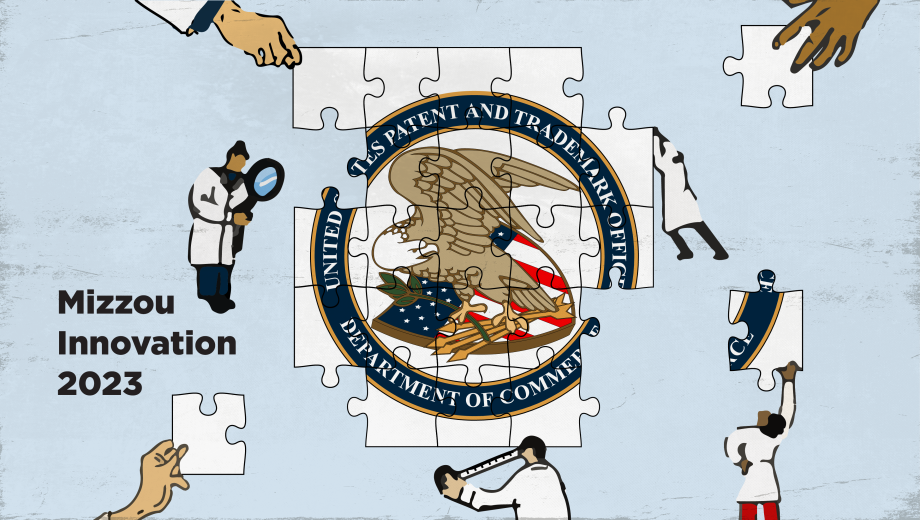July 15, 2024
Mizzou researchers work with the Office of Technology Advancement to protect and promote their discoveries.

In 2023, the University of Missouri received U.S. patents for a variety of faculty and staff inventions, including novel cancer therapies and a treatment for cardiovascular disease; a plant trait that increases the overall seed oil content in crops; improved engineering materials; a method to bioprint meat that could be a source of protein for countries suffering from war, famine or overpopulation; and a drinking container made with phase-change materials to rapidly cool and maintain liquids at drinkable temperatures.
The Technology Advancement team works with faculty and staff who have discoveries and innovations with commercial potential. Last year, researchers disclosed 113 inventions, which the team evaluated for novelty, utility and market potential.
Technical expertise from MU inventors and an analysis of scientific and patent literature, possible competitors and other factors guide the team’s marketing and intellectual property strategies.
113 New Inventions Disclosed
16 U.S. Patents Issued
$18.6M Licensing Income Generated
Often, an invention protected by a patent, copyright or trademark is an incentive for a company to invest in commercializing it. This intellectual property also can lead to successful grant proposals, new funding opportunities and partnerships that increase the odds that the research will result in a product or service.
Technology Advancement professionals understand that Mizzou’s intellectual property often sparks commercial ventures. Industry partners interested in further developing a Mizzou invention sign licensing agreements and pay fees. In fact, MU’s licensing income totaled $18.6 million in 2023.
In addition, the university was granted 16 U.S. patents for devices, tools, therapeutics and other inventions. Twenty-seven commercial partners licensed and optioned the rights to 59 different innovations. and four startup companies were created with MU-licensed technologies.
Researchers who think they have an innovation with commercial potential should submit a confidential Invention Disclosure Form to Technology Advancement. Call 573-882-6013 or email techadvancement@missouri.edu with questions.
U.S. patents issued in 2023 to Mizzou Engineers
Diagnostics and detection
Detection of biomarkers using plasmonic gratings
This method for producing a low-cost, fast and highly specific substrate includes enhanced fluorescent-based biomarker detection for imaging and medical diagnoses. (Patent No. 11,796,473)
- MU inventors: Shubhra Gangopadhyay, Sangho Bok, Aaron Wood, Keshab Gangopadhyay, Cherian Joseph Mathai, Syed Barizuddin and Sheila A. Grant
Therapeutics and treatments
Compositions for the treatment of drug-resistant tumors and methods of use thereof
These methods detect and treat tumors resistant to tyrosine kinase inhibitors (TKIs) using gelatin nanoparticles loaded with siRNAs and TKIs. (Patent No. 11,576,873)
- MU inventors: Raghuraman Kannan, Dhananjay Suresh, Soumavo Mukherjee, Ajit Prakash Zambre and Anandhi Upendran
Engineering solutions
Area selective nanoscale-thin layer deposition via precise functional group lithography
This method deposits nanoscale patterns used in nanoelectronics by applying ionizing radiation. (Patent No. 11,613,807)
- MU inventors: Matthew R. Maschmann and Matthias J. Young
Photonuclear transmutation doping in gallium-based semiconductor materials
This method makes high bandgap, gallium-based power transistors using gamma rays. (Patent No. 11,551,932)
- MU inventors: Jae Wan Kwon and Quang Nguyen
Composite material with high dielectric constant and use in biocompatible devices
This biocompatible implantable material with high dielectric constant could be used in medical devices, such as an implantable antenna, probe, sensor or electrodes. (Patent No. 11,844,881)
- MU inventors: Kevin A. O’Connor and Randy Curry
Devices and tools
Drinking container with different temperature zones
This drinking container utilizes phase-change materials to rapidly cool and maintain liquids at drinkable temperatures. (Patent No. 11,672,381)
- MU inventor: Bill Ma
Heat exchanging thermal liquid container
A drinking container utilizing phase-change materials that rapidly cools and maintains liquids at drinkable temperatures. (Patent No. 11,840,659)
- MU inventor: Bill Ma
Lid with automatic open and close retention mechanism
This mug lid is designed to work in conjunction with the novel drinking container described in Patents 11,672,381, 11,647,864 and 11,647,864. (Patent No. 11,603,238)
- MU inventor: Bill Ma
Thermal liquid container system with heat loss prevention lid
This drinking container and lid utilizes phase-change materials that rapidly cool and maintain liquids at drinkable temperatures. (Patent No. 11,647,864)
- MU inventor: Bill Ma
This story is part of a story originally published by the Research, Innovation & Impact – Administrative Office. Read the full story here.
At Mizzou, we create meaningful change in Missouri and across the world. Learn more about our high impact research, scholarship ad creative works.